As a follow-up to our egg formation post last week, now that we have a better understanding of what it takes to produce even one fresh egg, we thought we’d look a little closer at standard US egg grading, sizing, and freshness.
Egg Grading
Do you know what a USDA Grade AA egg is, versus a Grade A egg? Have you ever seen a Grade B egg? Most eggs sold commercially are graded, sorted, and packaged at US Department of Agriculture regulated facilities. Grades are assigned to eggs based on the interior quality of the egg, and the appearance and overall condition of the egg shell. Egg size has no relationship to egg grade.
According to USDA guidelines, eggs are graded, in descending order as:
U.S. Grade AA – eggs have whites that are thick and firm; yolks that are high, round, and practically free from defects (including blood spots, and meat spots); and clean, unbroken shells. Air cell depth may not exceed 3.2mm.
U.S. Grade A – eggs have characteristics of Grade AA eggs except the whites are “reasonably” firm. This is the quality most often sold in stores.
U.S. Grade B – eggs have whites that may be thinner and yolks that may be wider and flatter than eggs of higher grades. The shells must be unbroken, but may show slight stains. This quality is seldom found in retail stores because they are usually used to make liquid, frozen, and dried egg products, as well as other egg-containing products.
If you want fresh grade AA eggs, you really need to raise your own hens. Note that ‘grade’ is assigned to the eggs only, grade of the egg states nothing about the conditions under which the hens are raised.
Egg Sizing
Most consumers don’t think about egg-sizing. A recipe calls for one or two large eggs, most of us simply open the refrigerator, open an egg box, and retrieve the egg we need without a second thought.
You might assume that if you purchase a carton of “Large” Grade A eggs from the supermarket, that all of the eggs in the box fall into some definition of “Large”, but you’d be wrong. Eggs aren’t packaged by individual egg weight. Eggs packaged in containers marked “Medium”, “Large”, “Extra-Large” or “Jumbo”, simply are packaged by total carton weight, per one dozen eggs. Referring to the chart below, the first column is the ‘size’, and the next column lists, in ounces, the total weight of one dozen eggs (a carton) for that egg size, as defined by the USDA.
This means that one dozen “Large” eggs could contain some eggs that are significantly smaller, or larger than others, providing the total carton weight is approximately 24 ounces, all eggs in that carton are, based on an average, “Large” for the purpose of sale. This means a large egg should weigh, on average, 2 ounces. That’s all it is, an average weight.
If you raise your own chickens, your eggs don’t come pre-graded or sorted by size.
You may raise bantam chickens, that lay smaller eggs than standard breeds, or like us, you may have young pullets that start out laying peewee eggs, or old hens that routinely lay jumbo eggs. If you simply cook your eggs in an omelet, scrambled, boiled, or fried, sizing isn’t really that important. However, if you’re baking with eggs, especially more sensitive recipes like souffles, crème brûlée and custards, the size of the eggs becomes much more important.
Our smallest pullet eggs a few weeks ago were peewee-sized (based on USDA average per egg weights) at 34 grams in weight. Our pullets have been laying now for just over 30 days, and their average egg weight now is closer 50 grams, or medium-sized. However, our mature hens only lay jumbo eggs, between 68-72 grams.
To show the difference egg size can make in some recipes, this frittata typically uses 2 cups (16 fl oz) by volume of fresh eggs.
In the past, for our young standard breed hens, on average that has been equal to approximately 8 eggs for 16 fl oz. However, when I made this frittata last week with our young pullet eggs, it took 12 whole eggs to equal 16 fl oz. That’s four more eggs than we typically use.
This is a recipe I make often, so I happened to know by volume how much egg we usually use and the conversion was simple, but most recipes don’t list egg usage by volume, they only state size, so it’s helpful to have a rough idea as to the size of the eggs your hens are laying, and an egg-scale becomes a valuable kitchen tool to have around.
Egg Freshness
We know our eggs are fresh, as every morning we pull them, still warm from the nest boxes (lately, usually from underneath one of two broody Buff Orpingtons).
If you purchase your eggs from the Farmer’s Market, they likely were laid sometime that week, and if there’s any doubt, you can ask the vendor. However, if you buy your eggs at the supermarket, how fresh are they, really? They’re laid, graded, sorted, washed, packaged, loaded on trucks, transported, and eventually stacked on the shelves of market refrigerators, and can remain there up to their “sell-by” date. You can ask the store manager how fresh the eggs are, but he or she likely won’t be able to tell you, unless they can read the code stamped on the end of an egg carton.
So, how do you read egg carton codes?
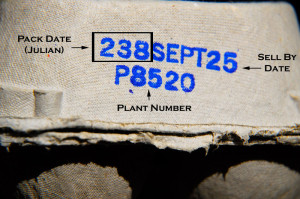
This egg carton shows the date the eggs were packaged, the sell-by date, and the facility code where the eggs were packed
This carton code begins with a three digit code, the Julian Date, that is the day the eggs were packaged into the carton (NOT when they were laid). This three digit number represents the day of the year. As there are 365 days in a year, day 238 would be August 26th. You can use simple online Julian-to-Calendar-Date converters online to help calculate this value for you.
The most familiar part of the code listed is the “sell-by” date, in this case “Sept25”. Here we can see that these eggs should be sold by September 25. When a “sell-by” date appears on a carton bearing the USDA grade shield, the code date may not exceed 45 days from the date of packing. This means that if you’re eating eggs close to the sell-by date, they could already be at least five weeks old.
The code below the date information, is the packaging plant code, where the eggs were graded, sorted, and packed.
Eggs from your own chickens however don’t come pre-stamped with a sell-by date. An easy test to determine if your eggs are fresh, or old, is to float them in water. As eggs age, the air cell enlarges, so older eggs are more buoyant when floated in a bowl of water than fresh eggs, which will sink. An egg that floats isn’t necessarily bad, but it is old.
There are clues as to how fresh your eggs are when they’re cracked open into a bowl too. A cloudy white (albumen) is a sign the egg is very fresh. Even we were surprised the first time we noticed this. Market egg whites are rarely cloudy. A clear egg white is an indication the egg is aging. As eggs age, the egg white also becomes thinner, and the chalaza become weaker and less prominent, causing the yolk position to move off center. Foul odors obviously indicate the egg has spoiled, and should be discarded.
There’s nothing better than a truly fresh egg. How old are the eggs in your refrigerator?

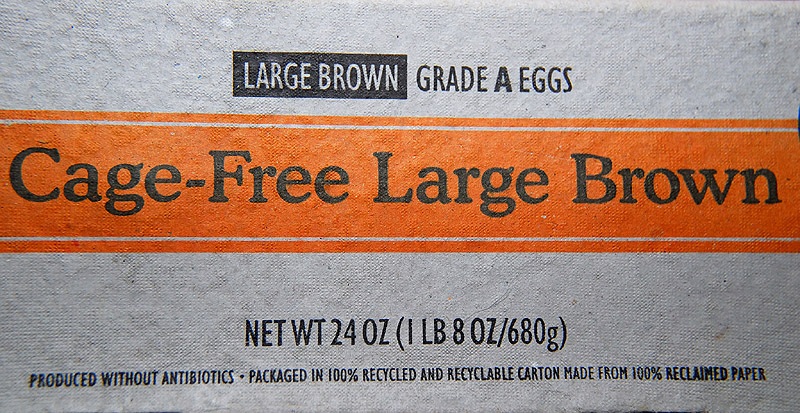
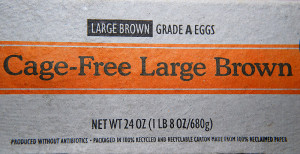
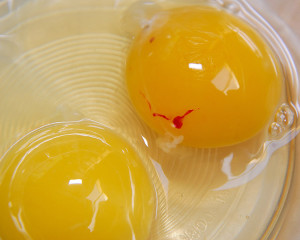

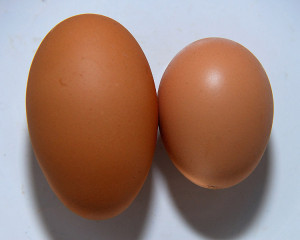

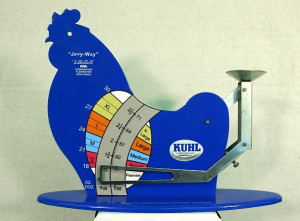
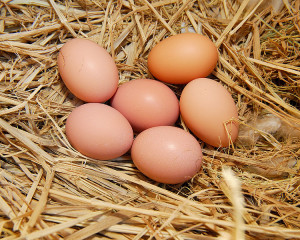








I’m a little behind on my blog reading, but Fowl Friday is always high on my list! Lots of good information here this week. I had no idea that eggs were sized by the carton weight. I just assumed it was based on the individual egg sizes.
We just picked up our CSA eggs today, so I am confident ours are fresh. They have been in short supply lately, due to hot weather and young hens. Today’s batch seem to be running large, since a dozen weighed in at 28 oz.
It’s dinner time here, and your frittata is making my mouth water! 😉
The carton weight surprised us the first time we learned of it. As for the hot weather, it’s quite remarkable to track the variation in egg-laying during heat spells (like the one we’re having now). I think the hens all band together, and refuse to work under such scorching working conditions 😛
Wow – very helpful information! I had no idea how old my eggs were, really. I would have thought the clearer whites meant fresher eggs!
It does seem counter intuitive. The first time I saw a cloudy egg-white, I was sure something was wrong! Shows how brain-washed we get with supermarket foods! 😛
You are lucky to have fresh eggs laid by your own chicken. The information was really very helpful. Thank you
Thanks for stopping by Lilit! I’m glad you found the information useful 🙂
Dear Clare, I learn so much from your postings and have been absolutely fascinated by the Fowl Friday series. The only piece of information here that I had known previously was about floating eggs in water to know how fresh they are. I think that this tip came from Delia Smith, one of the UK’s celebrity chefs.
With each posting, I become more convinced of the need to seek out a reliable source of fresh eggs from well reared chickens. I am going to make it a mission!
As I first learned that tip from either my mother, or my grandmother, it wouldn’t surprise me if they in turn learned it from Delia! I still have an ancient edition of ‘Delia Smith’s Complete Cookery Course’ sitting on my kitchen bookshelf!
Thanks for the great information. Like other commenters I have but under some false illusions regarding the eggs I buy. Keep it coming!
I have learned so much from your chicken posts. I have a bunch of fresh eggs from my sister’s chickens and now know how to tell how fresh they are. They are super fresh when I get them, but I do not always use them right away.
So interesting. I’m still waiting for fresh eggs 🙂 The pullets are 20 weeks old now.
It’s probable that I will never buy another commercial egg! We have fresh eggs available at farmers’ markets and I like supporting them and the tasty eggs. Clair, I just love that scale! gail
The scales are cute, aren’t they? Not complicated, but a nifty addition to the kitchen for the home baker 🙂
Your frittata looks scrumptious. I just took a look at the eggs in my refrigerator. The labeling on European eggs is different from what you described, as I have now discovered. They come in sizes L, M and S, which refers to weight, and each individual egg has a stamp showing country of origin, code number of egg farm, and a code showing whether hens were organically raised, raised in cages, or raised with ground contact. The outside package shows how long they’ll keep. There doesn’t seem to be any grading of quality. Interesting!
Maybe someday the USDA here will catch up. I love that every egg of yours is labeled, and that you have the knowledge as to the conditions under which the hens were raised. Seems simple really, in this age of mechanized sorting systems. Here we’re mostly kept in the dark.
Have so enjoyed your informative egg series, Clare. ‘Egg’actly the fascinating info I have often wondered about.
Dear Clare – you’ve given me lots of great info again this week. I used to hear my mum and grandma talk about the size of eggs as they both were great bakers and I used to see them test eggs by placing them in water.
I get my happy eggs from my friends happy hens as I love their deep yellowish orange yolks while at the supermarket they have a pale yellow yoke but the next time I get them from the supermarket I must check to see if they have similar info to USA on the sides of the cartons.
As Barbara suggested above, there are some differences in labeling between Europe and here. I’d be curious to see the differences between Britain (as I honestly don’t remember, it’s been so long), versus mainland Europe.
Very informative post. I never knew why some egg whites were cloudy and some clear. We go through so many eggs at my house. My 14 year old will eat about 5 scrambled eggs at one time. Eggs don’t last very long with three boys. 🙂 The frittata looks delish!
I’ve had a few requests to post the frittata recipe. May have to have an egg-recipe-centric Fowl Friday post in the very near future 😛
That would be great! I would love it.
More reasons why I should be keeping chickens! I’m going to insist my husband reads this post. Pam
If you love fresh eggs, and you garden, I’d say you have nothing to lose (providing you protect your young seedlings from curious hens). I honestly can’t imagine having a garden without chickens now, and they’ve done absolute wonders for our winter greens thus far! 😀
This was a most informative post. I learned so much. I always wondered about egg size. At the market I would switch out the eggs for ones that looked to ME to be large or extra large eggs. Now I see it is by weight. And reading the code. I never new that eggs can be sitting around for five weeks. I always wanted chickens, I guess I am going to have to move.
Our eggs are just a couple of days old at the most. Of course that’s why we have chickens. =)
And it is interesting to note (I think) that when you boil an egg, you can really tell how fresh it is. If it is almost impossible to get the shell off without destroying the egg, it is fresh. When the shell peels off neatly, it is an old egg. We plan to set aside a few eggs to age for that purpose when all our pullets start producing. For now, we use store bought eggs for boiling. 🙂
Fresh eggs, however, are supposed to poach much better, but I’ve never poached an egg, so I wouldn’t know. I do love the color of fresh eggs. Even in pancake better, they make it look so much more “alive!”